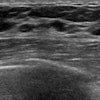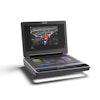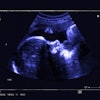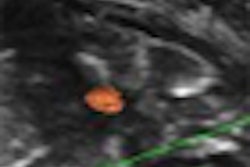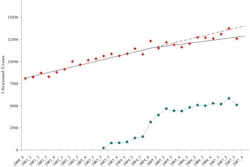Antenatal ultrasound does not appear to be associated with an increased risk for autism spectrum disorders (ASD), according to a study published online this month in the Journal of Autism and Developmental Disorders.
California researchers found that there was no relationship between the number of ultrasound scans and autism risk when a group of children with autism was compared to a group of normal controls. They believe their results may refute anecdotal theories that have connected rising autism rates with the increased use of prenatal ultrasound.
The research team, led by Judith Grether, Ph.D., from the California Department of Public Health in Richmond, CA, retrospectively evaluated singleton and control children enrolled in the Kaiser Permanente of Northern California (KPNC) healthcare system who were born between 1995 and 1999 (J Autism Dev Disord, September 1, 2009).
ASD cases were defined as singleton children with at least one diagnosis of an autism spectrum disorder (i.e., autism, Asperger's syndrome, or pervasive developmental disorder not otherwise specified) based on International Classification of Diseases criteria. Each ASD case was matched to a singleton control case from a cohort of KPNC births without an ASD diagnosis, with researchers trying to match ASD cases and control children based on gender, birth year, and hospital of birth, according to the researchers.
The study team then obtained clinical data from multiple sources within KPNC to identify the antenatal ultrasound examinations that children had received, the date and time of scans, gestational age at time of scans, and the type of scans.
The final study included 362 children with ASD from simplex families (in which a child has autism but parents and other siblings are unaffected) and 393 control children. The mothers of children with ASD had significantly greater mean maternal age than mothers of children in the control group, although the age was not significantly different when evaluated in five-year categories.
The mothers of children with ASD also had more years of education than mothers of children in the control group. In addition, the mean birth age of children with ASD was somewhat less than for the control children, a difference which approached statistical significance, the researchers noted.
Of the children with ASD from simplex families, 13% had no exposure to ultrasound examinations, compared with 12.5% in the control group. The majority of ultrasound exams were performed in the second trimester; 77.9% of ASD cases and 79.2% of the control group had one or more scans during this period. Approximately 28% of both ASD cases and controls had at least one scan in the first and third trimester.
From unadjusted analyses using a chi-square trend test, the study team determined that the number of ultrasound examinations was not significantly associated with ASD status during the entire gestational period or for any trimester.
Using logistic regression models, the researchers observed no significant or consistent increased risk of ASD with increasing numbers of antenatal ultrasound examinations for the total gestation or any trimester when ultrasound frequency was used as a continuous variable. They did note an elevated risk for females, however, in the second trimester when ultrasound was treated as a continuous variable in adjusted models, but not when ultrasound was treated as a categorical variable.
"This finding cannot be attributed to one or two outliers but could represent a chance finding among the large number of comparisons we conducted; alternatively, there may be risk associated with multiple [ultrasound exams] for girls in the second trimester or with medical indications for repeated [ultrasound exams] during this window of gestation," the researchers wrote.
In models that treated the frequency of ultrasound as a categorical variable, the researchers did not find a statistically significant elevation in risk with increasing numbers of antenatal ultrasound examinations for the total gestation or any trimester.
"When boys or girls were evaluated separately in models that treated frequency as a categorical variable, no significant elevations in risk were seen for the total pregnancy or for any trimester," they wrote.
The researchers noted that studies of phenotypic subgroups remain to be conducted and as antenatal ultrasound technologies and procedures change, further evaluation of potential risks may be warranted. In addition, the study did not address other possible risks to fetuses associated with antenatal ultrasound. But overall, use of prenatal ultrasound does not appear to be linked to autism, they concluded.
"The predominately null findings of this investigation of fetal exposure to antenatal ultrasound and risk of autism spectrum disorders may provide assurance that antenatal ultrasound examinations, when performed in a clinical setting according to established guidelines, do not appear to put fetuses at increased risk for developing ASD," the researchers wrote.
By Erik L. Ridley
AuntMinnie.com staff writer
September 10, 2009
Related Reading
MRI spots brain abnormality in autistic children, May 4, 2009
Finger tapping with fMRI reveals autism secrets, April 28, 2009
MEG reveals sound processing delays in autistic children, December 2, 2008
Study maps brain abnormalities in autistic children, November 29, 2007
Studies shed light on autism effects and treatment, December 6, 2006
Copyright © 2009 AuntMinnie.com


